Former Home of the Washington Nationals in Washington, D.C.
D.C. Stadium (1962-1968)
Robert F. Kennedy Memorial Stadium (1969-2007)
-----
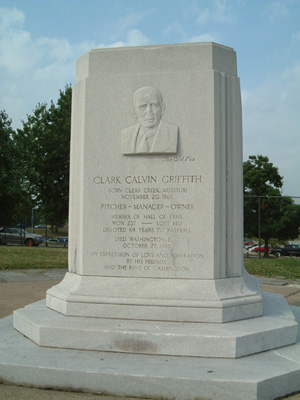 In just over 40 years RFK Stadium saw two different baseball teams call the facility home, a major riot, and a number of presidents throw out the first pitch. The political nature of the city means some presidents would get boos or cheers based on their poll numbers instead of their throw to the plate. One president would even send his vice-president in his place because he was worried about the reception he would get. RFK Stadium would begin its life just after Washington's baseball team left town for the Midwest.
In just over 40 years RFK Stadium saw two different baseball teams call the facility home, a major riot, and a number of presidents throw out the first pitch. The political nature of the city means some presidents would get boos or cheers based on their poll numbers instead of their throw to the plate. One president would even send his vice-president in his place because he was worried about the reception he would get. RFK Stadium would begin its life just after Washington's baseball team left town for the Midwest.
Attendance at Griffith Stadium for Washington Senators games was abysmal, and that may have been due to their equally-abysmal play on the field. After the 1960 baseball season the original Washington Senators moved to Minnesota to become the Twins, where they would win a World Series a few years later. The United States Congress had already approved a new stadium for baseball and football so The District of Columbia was quickly granted an expansion team. The new Washington Senators joined Major League Baseball along with the Los Angeles Angels, and after playing the 1961 season in Griffith Stadium the team moved to the newly-built D.C. Stadium the next season, where the Washington Redskins had already played a full football season. D.C. Stadium would be the first stadium built specifically to house both baseball and football, and it ushered in the era of "cookie-cutter" stadiums.
D.C. Stadium, as RFK Stadium was originally known, was the first of many of the cookie-cutter, doughnut-shaped, dual-use stadiums built for baseball and football during the 1960s and 1970s. The dual-use came at quite a cost for RFK, however. To convert the stadium from baseball to a soccer or football configuration cost $40,000 for each switch. The seats along the 3rd base line on the lower-level needed to be moved into the outfield, the pitcher's mound was lowered into the ground through the use of hydraulics, and other expensive changes made up the $40,000 cost. Later dual-use facilities found unique ways to avoid these problems, but RFK still had to pony up the $40,000 for each switch, of which there were 20 in 2005. The maintenance crew at RFK was worried that the seats along the 3rd base line, which hadn't moved since the Senators moved out, wouldn't work when they tried to move them back to a baseball configuration, but after some creaking and grinding the seats slowly moved along the track when they were first moved again before the 2005 baseball season.
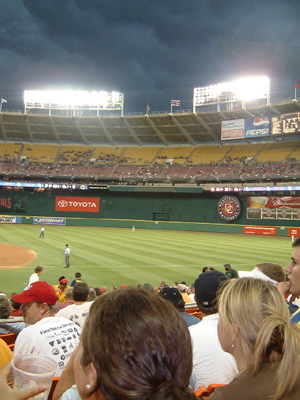 The outfield is one of the unique features of RFK Stadium. All of the seats in the outfield are in the upper deck, high atop the giant outfield wall. Frank Howard, a home run hitter for the Senators during the late 60s, hit a great number of tape-measure shots into those seats, and each seat that a home run of Howard's hit was painted white instead of the traditional yellow of the majority of the seats in the upper deck. Unfortunately, these seats were painted over when the Senators left Washington as the Redskins took over the park and made the seats match their color-scheme. The stadium is also the site of a famous home run hit by White Sox Hall of Famer Luke Appling. In July of 1982 Appling hit a short 250-foot homer to the left-field foul pole off of Atlanta Braves Hall of Famer Warren Spahn while the stadium had not been fully reconfigured.
The outfield is one of the unique features of RFK Stadium. All of the seats in the outfield are in the upper deck, high atop the giant outfield wall. Frank Howard, a home run hitter for the Senators during the late 60s, hit a great number of tape-measure shots into those seats, and each seat that a home run of Howard's hit was painted white instead of the traditional yellow of the majority of the seats in the upper deck. Unfortunately, these seats were painted over when the Senators left Washington as the Redskins took over the park and made the seats match their color-scheme. The stadium is also the site of a famous home run hit by White Sox Hall of Famer Luke Appling. In July of 1982 Appling hit a short 250-foot homer to the left-field foul pole off of Atlanta Braves Hall of Famer Warren Spahn while the stadium had not been fully reconfigured.
The first pitch at D.C. Stadium was thrown by President John F. Kennedy in 1961. The Kennedy family was known to love sports, and President Kennedy had been an avid baseball fan even while he was a Senator from Massachusetts. Kennedy was known to have appointed an official scorekeeper and stat advisor while he was a senator whom he termed "Undersecretary of Baseball." While most presidents will throw out the first pitch of a baseball game and then leave after an inning or two, Kennedy never left a game early that he attended at D.C. Stadium. When President Kennedy was assassinated in Dallas in 1963 it deeply affected his brother Robert Kennedy, who had just celebrated his birthday two days earlier. His grief over the tragedy shone through at the 1964 Democratic National Convention when the emotionally-fragile Kennedy broke down in tears at the podium in the face of a standing-ovation from the crowd. Robert worked his way through the speech, but broke down again afterwards. Robert declared his candidacy for the Presidency in March of 1968, and began to run the gamut of primaries. Although Kennedy had not been officially running for the initial New Hampshire primary he won the Indiana and Nebraska primaries soon afterwards. In June of 1968 he scored major victories in South Dakota and California, and, after addressing supporters at the Ambassador Hotel in Los Angeles on June 5, Kennedy left the ballroom of the hotel through a service area to greet workers in the hotel kitchen. In the crowded kitchen Sirhan B. Sirhan, a 24-year-old resident of L.A. who faulted Kennedy for his support of Israel in the Six-Day War of 1967, shot Kennedy in the head at close range. Robert Kennedy died in the early morning of June 6, and was buried in Arlington National Cemetery near his brother. The next year D.C. Stadium was renamed Robert F. Kennedy Memorial Stadium in honor of the slain senator of Camelot.
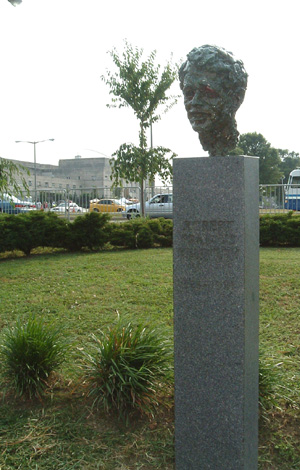 The new Washington Senators never really contended for a pennant, even after hiring Ted Williams as manager before the 1969 season. In the middle of the 1971 season franchise owner Bob Short, who was tired of the minimal fan support and the terms of the stadium lease deal with the city, accepted a stadium deal from Arlington, Texas that would be fully-funded by the city of Arlington. Short would move his team west at the end of the 1971 season to create the Texas Rangers. This led to a lot of anger from fans of the Senators, and it all boiled over during the team's final game at RFK Stadium on September 30th, 1971. The crowd was noisy and unruly from the beginning. One woman carried around a styrofoam dummy of owner Bob Short through the stadium as fans shouted "Why don't you show, chicken Short?" A large "Short Stinks" banner was unveiled in the bleachers, "We've been short changed" signs appeared around the stadium, and older fans recalled that the last time the Senators won the pennant the New Deal was actually new. It looked like the crowd of 14,460 were going to see a Senators victory with their team leading 7-5 against the New York Yankees with two outs in the 9th, but several hundred fans suddenly surged onto the field. Some ran the bases while others tore out blades of grass, pocketed infield dirt, or took possession of stadium items such as the ball boys' folding chairs. The players on the field seemed to care as little about the intrusion as the fans still in the stands, but when some fans literally stole first base the police began to take action. The stadium lights were dimmed, the groundskeepers dug up the pitching rubber under police guard, and four police officers stood around home plate to keep it safe. The Senators were forced to forfeit their final game at RFK Stadium by an official score of 9-0.
The new Washington Senators never really contended for a pennant, even after hiring Ted Williams as manager before the 1969 season. In the middle of the 1971 season franchise owner Bob Short, who was tired of the minimal fan support and the terms of the stadium lease deal with the city, accepted a stadium deal from Arlington, Texas that would be fully-funded by the city of Arlington. Short would move his team west at the end of the 1971 season to create the Texas Rangers. This led to a lot of anger from fans of the Senators, and it all boiled over during the team's final game at RFK Stadium on September 30th, 1971. The crowd was noisy and unruly from the beginning. One woman carried around a styrofoam dummy of owner Bob Short through the stadium as fans shouted "Why don't you show, chicken Short?" A large "Short Stinks" banner was unveiled in the bleachers, "We've been short changed" signs appeared around the stadium, and older fans recalled that the last time the Senators won the pennant the New Deal was actually new. It looked like the crowd of 14,460 were going to see a Senators victory with their team leading 7-5 against the New York Yankees with two outs in the 9th, but several hundred fans suddenly surged onto the field. Some ran the bases while others tore out blades of grass, pocketed infield dirt, or took possession of stadium items such as the ball boys' folding chairs. The players on the field seemed to care as little about the intrusion as the fans still in the stands, but when some fans literally stole first base the police began to take action. The stadium lights were dimmed, the groundskeepers dug up the pitching rubber under police guard, and four police officers stood around home plate to keep it safe. The Senators were forced to forfeit their final game at RFK Stadium by an official score of 9-0.
The nation's capital was without Major League Baseball for 33 years, apart from 16 exhibition games. This was mostly due to fears from the ownership of the Baltimore Orioles that a new team in D.C. would hurt their marketshare. Things began to change, though, when Major League Baseball purchased the Montreal Expos from owner Jeffrey Loria, who had been complaining for years about the inability for a small-market team like Montreal to compete with the larger markets of New York, Chicago, and Los Angeles. MLB purchased the team in February of 2002 thinking the Expos would be contracted along with the Minnesota Twins. However, a series of lawsuits prevented the contraction of the Twins, and a new collective bargaining agreement had specific clauses that prevented contraction through the 2006 season. Major League Baseball was forced to keep the Expos, and they named Frank Robinson the team's manager for the 2003 season. During that season the team played 22 home games at Hiram Bithorn Stadium in San Juan, Puerto Rico. Although it was a much smaller stadium than Montreal's Olympic Stadium, Hiram Bithorn regularly outdrew its Canadian counterpart. The Expos were in the hunt for the Wild Card late in the season, but MLB commissioner Bud Selig announced that the Expos would not be allowed to call up players from the minor leagues as it was deemed too expensive. This was the death sentence for the Expos in Montreal as fans stopped going to games while the Expos finished eight games out of the Wild Card. During the 2004 season the Expos again played games in San Juan, but this year MLB was actively searching for a place for the Expos to land. They set a deadline of July for the decision to be made.
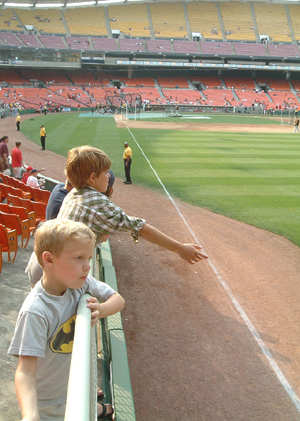 A number of sites were attempting to woo the Expos during the 2004 baseball season. Washington D.C., Portland, Oregon, Las Vegas, Nevada, Norfolk, Virginia, and Northern Virginia all tried to prove that they were a viable market for Major League Baseball. San Juan, Puerto Rico and Monterrey, Mexico also submitted bids in an attempt to keep the Expos out of the continental United States. Major League Baseball wanted a city that would pay for their own stadium, however, and although attendance in San Juan's Hiram Bithorn Stadium was exemplary, it was still a much smaller stadium than any in baseball, and San Juan was unlikely to build a new stadium. Many of the cities vying for the Expos were having trouble organizing a stadium plan, and Washington D.C. was no exception. As late as June of 2004 D.C. still did not have a solid stadium plan in place, and MLB had set a deadline of July to decide on the new city for the Expos. However, as oftentimes happens with dealings in baseball, the deadline came and went without a decision being made. In early August Portland and Monterrey were eliminated, but the time to make a decision was getting near as September 1 was the deadline for the 2005 schedule to be submitted. In late August the news was that the field had been narrowed to Washington and Northern Virginia, but MLB COO Bob DuPuy quelled those rumors by announcing that no more cities had been eliminated. At this point four bids, D.C., Northern Virginia, Norfolk, and Las Vegas were still in the running, but MLB was told that Washington's RFK Stadium would need at least six months to prepare for a new baseball team, which affected the Virginia bids as well as D.C. since the Virginia locations would use RFK temporarily while a new stadium was built. Also causing controversy was the fact that Baltimore Orioles owner Peter Angelos was unhappy with the Virginia and D.C. sites as he was worried they would take away from the Orioles' fan base. Major League Baseball placated Angelos by establishing a minimum price for the Orioles if Angelos ever decided to sell them. With Angelos happy it appeared that the Expos were going to be moving to either D.C. or one of the Virginia sites. Washington, though, wouldn't let the deal go through without playing some hardball.
A number of sites were attempting to woo the Expos during the 2004 baseball season. Washington D.C., Portland, Oregon, Las Vegas, Nevada, Norfolk, Virginia, and Northern Virginia all tried to prove that they were a viable market for Major League Baseball. San Juan, Puerto Rico and Monterrey, Mexico also submitted bids in an attempt to keep the Expos out of the continental United States. Major League Baseball wanted a city that would pay for their own stadium, however, and although attendance in San Juan's Hiram Bithorn Stadium was exemplary, it was still a much smaller stadium than any in baseball, and San Juan was unlikely to build a new stadium. Many of the cities vying for the Expos were having trouble organizing a stadium plan, and Washington D.C. was no exception. As late as June of 2004 D.C. still did not have a solid stadium plan in place, and MLB had set a deadline of July to decide on the new city for the Expos. However, as oftentimes happens with dealings in baseball, the deadline came and went without a decision being made. In early August Portland and Monterrey were eliminated, but the time to make a decision was getting near as September 1 was the deadline for the 2005 schedule to be submitted. In late August the news was that the field had been narrowed to Washington and Northern Virginia, but MLB COO Bob DuPuy quelled those rumors by announcing that no more cities had been eliminated. At this point four bids, D.C., Northern Virginia, Norfolk, and Las Vegas were still in the running, but MLB was told that Washington's RFK Stadium would need at least six months to prepare for a new baseball team, which affected the Virginia bids as well as D.C. since the Virginia locations would use RFK temporarily while a new stadium was built. Also causing controversy was the fact that Baltimore Orioles owner Peter Angelos was unhappy with the Virginia and D.C. sites as he was worried they would take away from the Orioles' fan base. Major League Baseball placated Angelos by establishing a minimum price for the Orioles if Angelos ever decided to sell them. With Angelos happy it appeared that the Expos were going to be moving to either D.C. or one of the Virginia sites. Washington, though, wouldn't let the deal go through without playing some hardball.
Near the end of August, D.C. councilman Jack Evans insinuated that if Virginia was given the Expos he would block them from using RFK Stadium while Virginia built their own stadium. This was analogous to the threat "I'll take my ball and go home" from the days of playing baseball as kids. "There would be enough anger in the city, including my own, that the council could pass legislation that would keep a northern Virginia team out of RFK," Evans said. Virginia Congressman Tom Davis responded by stating "Congress could overrule something like that in a heartbeat." Virginia baseball lobbyist Mike Scanion added fuel to the fire with his dig, "Virginia's got 11 votes in the House; D.C.'s got no votes in the House." Finally, on September 29, D.C. Mayor Anthony Williams announced that the Expos were moving to Washington. Commissioner Bud Selig confirmed the news the next day, and the Expos were well on their way to becoming the Washington Nationals. President George W. Bush kept the tradition of presidents throwing out the first pitch at RFK Stadium to start the 2005 season. He was a little less brave the next year, however, when he was suppose to throw out the first pitch on Tuesday, April 11. Given his slipping poll numbers it was obvious he wouldn't be given the warmest reception at RFK, so citing a "scheduling conflict" the president sent Vice President Dick Cheney to the mound instead. Cheney got the expected response as a series of boos and jeers welcomed him to the pitcher's mound. He did get a number of cheers, though, when his throw short-hopped the plate. Such is life in Washington.
Getting There
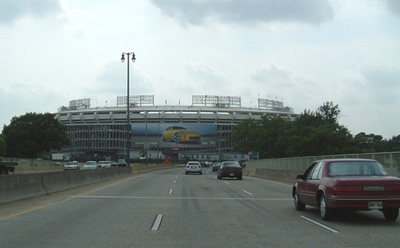
It was incredibly easy to get to RFK Stadium (+1), although I admittedly went to the park obscenely early. I drove to the stadium and the parking lot is huge (+1), although I imagine traffic around the stadium can be a bit confusing when there are more cars around. Traffic to the stadium is routed away from local traffic (+1), though, which is definitely a good thing. D.C. also has an extensive subway system that you can use (+1) to cheaply arrive at RFK Stadium (+1). Really, I have absolutely no complaints about transportation to RFK.
Score: 10/10
Tickets and Seating
The Nationals have a number of options to sell tickets, including a Ticket Replay system that allows fans with season tickets to resell their unused tickets (+1) and a number of teams use similar systems now. This is a great way of avoiding the problem of season ticket holders not showing up for games. The Nationals have a great variety of tickets available at different prices (+1). You could spend $7 to sit in the upper part of the outfield, or $105 to sit in the Diamond Club seats right behind home plate. Box seats seem to be consistent with tickets around MLB in the $40-$50 range (+1). The aisles and rows at RFK are pretty narrow, but that doesn't matter when you're sitting in your seat. What does matter is that the rows in the grandstand are barely elevated so shorter fans may have trouble seeing during a packed game (-1). This wasn't a problem for me, though, as I'm not short and the game I went to was far from packed especially after the rain started. The opposite problem happens in the upper deck as the rows are so steep that I can actually say it is steeper than U.S. Cellular's upper deck (-1). Overall, most of the seats offer a decent view of the field, and it is certainly better than most of the cookie-cutter stadiums out there (+1).
Score: 7/10
Exterior
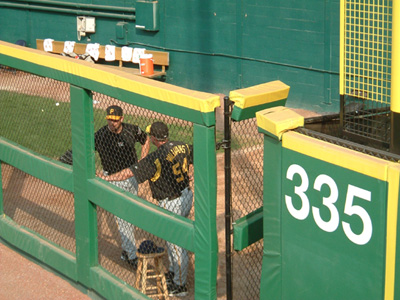
RFK Stadium really shows its age on the outside. The gray concrete is accentuated by the white pillars holding up the wavy upper deck (-1). The pillars all seem to have the same orange rust which really gives away the age of the stadium (-1). There is very little to see on the outside of the stadium other than the acres of parking. The main entrance does have a small garden with a bust of Robert F. Kennedy (+1) and a Redskins logos. The only real baseball reference is a stone commemorating Clark Griffith, former owner of the Senators, but the stone was also present at the old Griffith Stadium so it was nothing new. Otherwise, the outside of RFK is pretty boring, but the stadium does look cool from a distance because of the unique upper deck (+1).
Score: 5/10
Interior
Although RFK Stadium is a cookie-cutter stadium it is definitely the nicest of the genre that I have seen (+1). The waves created by the top of the stadium look pretty cool from the inside (+1), and they occur from foul pole to foul pole. The outfield at RFK features a gigantic green wall, reminiscent of Fenway's Green Monster, although on a grander scale (+1). Right field also features a classic-looking clock with a DC logo (+1). Getting the good aspects of the park out of the way, it is of the loathsome cookie-cutter genre so the park is not without many faults. The stadium is fully-enclosed so there is no view of Washington D.C. (-1), and great views of the nearby Anacostia River might have been seen had the ballpark not been enclosed. There is also very little inside the stadium aside from the field itself to give away the fact that it is home to a baseball team (-1). There are some signs in right field celebrating D.C. sports stars, but the majority are players from the D.C. United, the soccer team that also calls RFK home. Overall, the inside of RFK Stadium is pretty bland with nothing save the curved roof. RFK still seems to be a football stadium (-1), as evidenced by the color scheme of the Redskins that it still possesses, and that is unlikely to change in the few years the Nationals will call the stadium home.
Score: 6/10
Scoreboard
The main scoreboard at RFK is located above the right-field upper deck. The videoboard is decent, but not among the best I've seen. There is a portion of the board that displays a wide array of stats (+1), but the problem with the scoreboard is that it is very sterile. There is no "classic baseball" feel to the scoreboard (-1), but that is consistent with the rest of the stadium so it shouldn't be a surprise.
Score: 5/10
Kid Friendly
As an older stadium, RFK does not have anything for kids to do other than watch the game (-2).
Score: 3/10
Fans
The Nationals fans seemed to enjoy having baseball back in DC (+1). They arrived at the stadium fairly late (-1), but were into the game until the rain delay (+1). There was a large contingent of fans of other teams that I seemed to be sitting with. None seemed to be fans of either team that was playing, though, which was pretty interesting. The fans were overall pretty nice (+1), but it was tough to tell since I wasn't sitting near many Nats fans.
Score: 7/10
Ushers and Trading Up
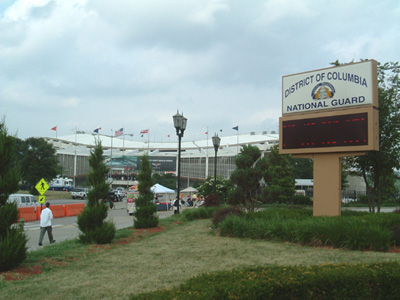
The ushers at RFK are pretty laissez faire, although they will help you find your seat if you need it (+1). However, this also means they don't care if you feel like trading up (+1). Although the lower box seats were pretty full when I was there I was able to move up a few rows in my section without a question from anyone (+1). I have also heard there is no problem "trading up" from the upper deck to the lower box seats as long as they are available (+1). This probably won't last in the Nationals' new stadium, but it's a nice policy for now.
Score: 9/10
7th Inning Stretch
Because of the rain delay I wasn't able to catch the 7th inning stretch at RFK. I do know that they play "Take Me Out to the Ballgame," (+1) which earns it some points, but the horrible sound system takes some points away (-1).
Score: 5/10
Surrounding Area
Around RFK you could visit the D.C. National Guard Armory (-1) or swing by the D.C. jail (-1). Other than that there really isn't anything to do near the stadium. There are a few concessionaires outside the stadium, but it really is pretty barren unless you travel a few miles towards the Mall area.
Score: 3/10
Final Score: 60/100
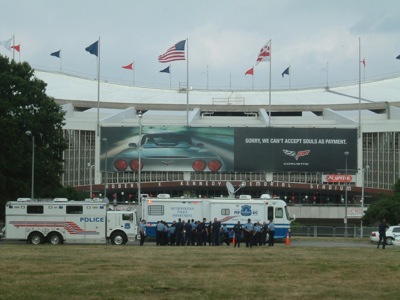

 In just over 40 years RFK Stadium saw two different baseball teams call the facility home, a major riot, and a number of presidents throw out the first pitch. The political nature of the city means some presidents would get boos or cheers based on their poll numbers instead of their throw to the plate. One president would even send his vice-president in his place because he was worried about the reception he would get. RFK Stadium would begin its life just after Washington's baseball team left town for the Midwest.
In just over 40 years RFK Stadium saw two different baseball teams call the facility home, a major riot, and a number of presidents throw out the first pitch. The political nature of the city means some presidents would get boos or cheers based on their poll numbers instead of their throw to the plate. One president would even send his vice-president in his place because he was worried about the reception he would get. RFK Stadium would begin its life just after Washington's baseball team left town for the Midwest. The outfield is one of the unique features of RFK Stadium. All of the seats in the outfield are in the upper deck, high atop the giant outfield wall. Frank Howard, a home run hitter for the Senators during the late 60s, hit a great number of tape-measure shots into those seats, and each seat that a home run of Howard's hit was painted white instead of the traditional yellow of the majority of the seats in the upper deck. Unfortunately, these seats were painted over when the Senators left Washington as the Redskins took over the park and made the seats match their color-scheme. The stadium is also the site of a famous home run hit by White Sox Hall of Famer Luke Appling. In July of 1982 Appling hit a short 250-foot homer to the left-field foul pole off of Atlanta Braves Hall of Famer Warren Spahn while the stadium had not been fully reconfigured.
The outfield is one of the unique features of RFK Stadium. All of the seats in the outfield are in the upper deck, high atop the giant outfield wall. Frank Howard, a home run hitter for the Senators during the late 60s, hit a great number of tape-measure shots into those seats, and each seat that a home run of Howard's hit was painted white instead of the traditional yellow of the majority of the seats in the upper deck. Unfortunately, these seats were painted over when the Senators left Washington as the Redskins took over the park and made the seats match their color-scheme. The stadium is also the site of a famous home run hit by White Sox Hall of Famer Luke Appling. In July of 1982 Appling hit a short 250-foot homer to the left-field foul pole off of Atlanta Braves Hall of Famer Warren Spahn while the stadium had not been fully reconfigured. The new Washington Senators never really contended for a pennant, even after hiring Ted Williams as manager before the 1969 season. In the middle of the 1971 season franchise owner Bob Short, who was tired of the minimal fan support and the terms of the stadium lease deal with the city, accepted a stadium deal from Arlington, Texas that would be fully-funded by the city of Arlington. Short would move his team west at the end of the 1971 season to create the Texas Rangers. This led to a lot of anger from fans of the Senators, and it all boiled over during the team's final game at RFK Stadium on September 30th, 1971. The crowd was noisy and unruly from the beginning. One woman carried around a styrofoam dummy of owner Bob Short through the stadium as fans shouted "Why don't you show, chicken Short?" A large "Short Stinks" banner was unveiled in the bleachers, "We've been short changed" signs appeared around the stadium, and older fans recalled that the last time the Senators won the pennant the New Deal was actually new. It looked like the crowd of 14,460 were going to see a Senators victory with their team leading 7-5 against the New York Yankees with two outs in the 9th, but several hundred fans suddenly surged onto the field. Some ran the bases while others tore out blades of grass, pocketed infield dirt, or took possession of stadium items such as the ball boys' folding chairs. The players on the field seemed to care as little about the intrusion as the fans still in the stands, but when some fans literally stole first base the police began to take action. The stadium lights were dimmed, the groundskeepers dug up the pitching rubber under police guard, and four police officers stood around home plate to keep it safe. The Senators were forced to forfeit their final game at RFK Stadium by an official score of 9-0.
The new Washington Senators never really contended for a pennant, even after hiring Ted Williams as manager before the 1969 season. In the middle of the 1971 season franchise owner Bob Short, who was tired of the minimal fan support and the terms of the stadium lease deal with the city, accepted a stadium deal from Arlington, Texas that would be fully-funded by the city of Arlington. Short would move his team west at the end of the 1971 season to create the Texas Rangers. This led to a lot of anger from fans of the Senators, and it all boiled over during the team's final game at RFK Stadium on September 30th, 1971. The crowd was noisy and unruly from the beginning. One woman carried around a styrofoam dummy of owner Bob Short through the stadium as fans shouted "Why don't you show, chicken Short?" A large "Short Stinks" banner was unveiled in the bleachers, "We've been short changed" signs appeared around the stadium, and older fans recalled that the last time the Senators won the pennant the New Deal was actually new. It looked like the crowd of 14,460 were going to see a Senators victory with their team leading 7-5 against the New York Yankees with two outs in the 9th, but several hundred fans suddenly surged onto the field. Some ran the bases while others tore out blades of grass, pocketed infield dirt, or took possession of stadium items such as the ball boys' folding chairs. The players on the field seemed to care as little about the intrusion as the fans still in the stands, but when some fans literally stole first base the police began to take action. The stadium lights were dimmed, the groundskeepers dug up the pitching rubber under police guard, and four police officers stood around home plate to keep it safe. The Senators were forced to forfeit their final game at RFK Stadium by an official score of 9-0. A number of sites were attempting to woo the Expos during the 2004 baseball season. Washington D.C., Portland, Oregon, Las Vegas, Nevada, Norfolk, Virginia, and Northern Virginia all tried to prove that they were a viable market for Major League Baseball. San Juan, Puerto Rico and Monterrey, Mexico also submitted bids in an attempt to keep the Expos out of the continental United States. Major League Baseball wanted a city that would pay for their own stadium, however, and although attendance in San Juan's Hiram Bithorn Stadium was exemplary, it was still a much smaller stadium than any in baseball, and San Juan was unlikely to build a new stadium. Many of the cities vying for the Expos were having trouble organizing a stadium plan, and Washington D.C. was no exception. As late as June of 2004 D.C. still did not have a solid stadium plan in place, and MLB had set a deadline of July to decide on the new city for the Expos. However, as oftentimes happens with dealings in baseball, the deadline came and went without a decision being made. In early August Portland and Monterrey were eliminated, but the time to make a decision was getting near as September 1 was the deadline for the 2005 schedule to be submitted. In late August the news was that the field had been narrowed to Washington and Northern Virginia, but MLB COO Bob DuPuy quelled those rumors by announcing that no more cities had been eliminated. At this point four bids, D.C., Northern Virginia, Norfolk, and Las Vegas were still in the running, but MLB was told that Washington's RFK Stadium would need at least six months to prepare for a new baseball team, which affected the Virginia bids as well as D.C. since the Virginia locations would use RFK temporarily while a new stadium was built. Also causing controversy was the fact that Baltimore Orioles owner Peter Angelos was unhappy with the Virginia and D.C. sites as he was worried they would take away from the Orioles' fan base. Major League Baseball placated Angelos by establishing a minimum price for the Orioles if Angelos ever decided to sell them. With Angelos happy it appeared that the Expos were going to be moving to either D.C. or one of the Virginia sites. Washington, though, wouldn't let the deal go through without playing some hardball.
A number of sites were attempting to woo the Expos during the 2004 baseball season. Washington D.C., Portland, Oregon, Las Vegas, Nevada, Norfolk, Virginia, and Northern Virginia all tried to prove that they were a viable market for Major League Baseball. San Juan, Puerto Rico and Monterrey, Mexico also submitted bids in an attempt to keep the Expos out of the continental United States. Major League Baseball wanted a city that would pay for their own stadium, however, and although attendance in San Juan's Hiram Bithorn Stadium was exemplary, it was still a much smaller stadium than any in baseball, and San Juan was unlikely to build a new stadium. Many of the cities vying for the Expos were having trouble organizing a stadium plan, and Washington D.C. was no exception. As late as June of 2004 D.C. still did not have a solid stadium plan in place, and MLB had set a deadline of July to decide on the new city for the Expos. However, as oftentimes happens with dealings in baseball, the deadline came and went without a decision being made. In early August Portland and Monterrey were eliminated, but the time to make a decision was getting near as September 1 was the deadline for the 2005 schedule to be submitted. In late August the news was that the field had been narrowed to Washington and Northern Virginia, but MLB COO Bob DuPuy quelled those rumors by announcing that no more cities had been eliminated. At this point four bids, D.C., Northern Virginia, Norfolk, and Las Vegas were still in the running, but MLB was told that Washington's RFK Stadium would need at least six months to prepare for a new baseball team, which affected the Virginia bids as well as D.C. since the Virginia locations would use RFK temporarily while a new stadium was built. Also causing controversy was the fact that Baltimore Orioles owner Peter Angelos was unhappy with the Virginia and D.C. sites as he was worried they would take away from the Orioles' fan base. Major League Baseball placated Angelos by establishing a minimum price for the Orioles if Angelos ever decided to sell them. With Angelos happy it appeared that the Expos were going to be moving to either D.C. or one of the Virginia sites. Washington, though, wouldn't let the deal go through without playing some hardball. 

